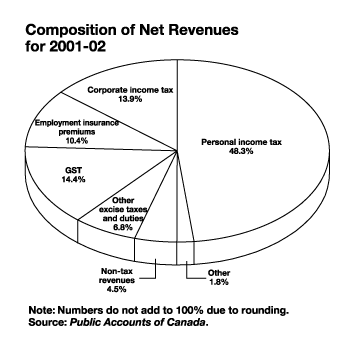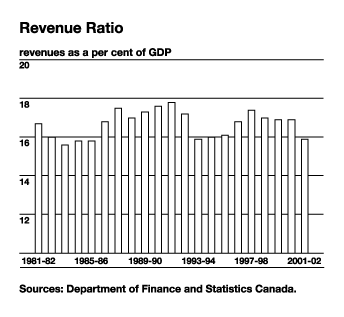|
|
Annual Financial Report 2001-2002: 2
- Table of Contents - Previous - Next -
Budgetary Revenues
Reflecting much slower growth in 2001 and the tax reductions introduced in the October 2000 Economic Statement and Budget Update, budgetary revenues declined by $6.3 billion, or 3.5 per cent, to $173.3 billion in 2001-02 after advancing by 8.1 per cent in the previous year. Declines were spread throughout most major components, with the exception of personal income tax revenues and excise taxes and duties (see Table 2). Even in these latter two components, the rates of increase were substantially less than those recorded in the previous fiscal year. This primarily reflected the impact of the global economic weakness on the various tax bases and the effect of the tax reduction measures announced in the February 2000 budget and October 2000 Economic Statement and Budget Update. These measures included the reduction in personal income tax rates; the elimination of the 5-per-cent surtax; increases in thresholds; the restoration of full indexation of the personal income tax system; and increases in the Canada Child Tax Benefit.
Personal income tax revenues, the largest component of budgetary revenues, were up only $0.5 billion, or 0.6 per cent, in 2001-02 due entirely to prior-year adjustments and the timing of receipts.
-
Gross remittances received include federal personal income tax, provincial income tax collected by the Canada Customs and Revenue Agency (CCRA) under the tax collection agreements with participating provinces, as well as employer and employee premiums for employment insurance (EI) and the Canada Pension Plan (CPP). Estimates are made for these various components on a monthly basis, with adjustments made once either preliminary or final data become available from the CCRA. In 2001-02 there were transfers of about $500 million from the EI and CPP accounts to personal income tax relating to overestimations of deductions for previous fiscal years.
-
There are also important collection lags between the economic event giving rise to personal income tax liabilities and the receipt of revenues. In April and May 2001 extraordinarily large final tax payments were received with respect to the 2000 taxation year, in large part due to the strong increases in capital gains realizations in 2000. Excluding the impact of the above factors, personal income tax revenues would have recorded a significant decline, reflecting the impact of tax reductions and weakness in economic growth.

Corporate income tax revenues declined $4.2 billion in 2001-02, or 14.9 per cent, following an increase of 21.8 per cent in 2000-01. This decline primarily reflected an estimated 8.9-per-cent decline in corporate profits. In addition, the December 2001 budget announced a six-month deferral of small business corporate income tax instalments for the last quarter of 2001-02 to assist small businesses with the economic slowdown. It is estimated that this measure reduced corporate income tax revenues in 2001-02 by about $600 million.
Table 2
Net Budgetary Revenues
|
|
||||
| 2000-01 | 2001-02 | Net Change | ||
|---|---|---|---|---|
|
|
||||
| ($ millions) | (%) | |||
| Net income tax collections | ||||
| Personal income tax | 83,305 | 83,790 | 485 | 0.6 |
| Corporate income tax | 28,212 | 24,013 | -4,199 | -14.9 |
| Other | 4,312 | 3,035 | -1,277 | -29.6 |
|
|
||||
| Total | 115,829 | 110,838 | -4,991 | -4.3 |
|
Employment insurance premium revenues |
18,731 | 17,980 | -751 | -4.0 |
| Net excise taxes and duties | ||||
| Goods and services tax | 24,990 | 24,909 | -81 | -0.3 |
| Customs import duties | 2,807 | 3,018 | 211 | 7.5 |
| Other excise taxes/duties | ||||
| Energy taxes | 4,805 | 4,758 | -47 | -1.0 |
| Other | 3,514 | 3,953 | 439 | 12.5 |
|
|
||||
| Total | 8,319 | 8,711 | 392 | 4.7 |
|
|
||||
| Total | 36,116 | 36,638 | 522 | 1.4 |
| Net tax revenues | 170,676 | 165,456 | -5,220 | -3.1 |
| Net non-tax revenues | ||||
| Return on investments | 6,144 | 5,892 | -252 | -4.1 |
| Other non-tax revenues1 | 2,770 | 1,967 | -803 | -29.0 |
|
|
||||
| Total | 8,914 | 7,859 | 1,055 | -11.8 |
| Net budgetary revenues | 179,590 | 173,315 | -6,275 | -3.5 |
|
|
||||
| Note: Personal income tax revenues for
2000-01 have been revised to reflect the misclassification of mutual
fund trust capital gain refunds.
1 "Refunds from previous years’
expenditures" was reclassified from "Other non-tax
revenues" to program spending. |
||||
Other income tax revenues were down $1.3 billion, or 29.6 per cent, primarily due to a consolidation adjustment relating to refundable taxes withheld from the federal Retirement Compensation Arrangements Account that were previously credited to tax revenues.
EI premium revenues were down $0.8 billion, or 4.0 per cent, as prior-year adjustments and the decline in premium rates more than offset the impact of the growth in the number of people employed and therefore paying premiums. The employee premium rate (per $100 of insurable earnings) was reduced from $2.40 for 2000 to $2.25 for 2001 and $2.20 for 2002 (with a corresponding decline in the employer rate).
Excise taxes and duties increased $0.5 billion, or 1.4 per cent. However, there were significant variations among the various components.
-
Goods and services tax (GST) revenues were marginally lower, reflecting declines in GST collected on imported goods and higher rebates.
-
Customs import duties increased $0.2 billion, or 7.5 per cent.
-
Other excise taxes and duties were up 4.7 per cent, primarily due to the increase in excise tax rates on tobacco products. Energy taxes were slightly lower, reflecting lower taxes collected on aviation fuel.
Non-tax revenues declined $1.1 billion, or 11.8 per cent, in 2001-02, primarily reflecting lower Bank of Canada profits and interest on bank balances due to the decline in interest rates. In addition, "refunds from previous years’ expenditures," which in previous years was included as part of "other non-tax revenues," is now netted against program spending. This has the effect of lowering both budgetary revenues and program spending by an equivalent amount, with no impact on the overall budgetary balance.
The revenue ratio – budgetary revenues as a percentage of GDP – represents a comprehensive measure of the overall "tax burden" in that it compares the total of all revenues collected to the size of the economy. The revenue ratio stood at 15.9 per cent in 2001-02, compared to 16.9 per cent in 2000-01. It is now at its lowest level since 1993-94. The decline in the ratio between 2000-01 and 2001-02 reflects the impact of the tax reductions announced in the February 2000 budget and the October 2000 Economic Statement and Budget Update, as well as the impact of the global economic slowdown.
It should be noted that some important components of income subject to taxation are excluded from the Statistics Canada measure of GDP, such as capital gains and income from trusteed pension plans. As a result, this ratio overstates the tax burden. In addition, the sharp rise in capital gains and the growth in income from trusteed pension plans due to the aging of the population distort year-to-year changes in the ratio. Therefore, caution should be exercised in interpreting this ratio.

The figures in Table 2 are presented on a "net" basis, reflecting the way in which revenues and expenditures are presented to Parliament and in the Government’s annual budget. In this presentation, the Canada Child Tax Benefit, the quarterly GST credit and the repayments of Old Age Security benefits are netted against income tax revenues. Certain departmental revenues, such as the revenues of consolidated Crown corporations and revenues levied by departments for specific services (such as the contract costs of policing services in provinces), are netted against spending. This classification has the effect of reducing both revenues and spending but has no impact on the budgetary balance.
Table 3 shows the impact of "grossing up" budgetary revenues for these adjustments. In 2001-02 they amounted to $14.2 billion, of which over half was due to the Canada Child Tax Benefit. As a result, gross budgetary revenues were $187.5 billion in 2001-02, down 3 per cent from 2000-01.
Table 3
Gross Budgetary Revenues
|
|
||||
|
2000-01 |
2001-02 |
Net Change |
||
|---|---|---|---|---|
|
|
||||
| ($ millions) | (%) | |||
|
Net budgetary revenues |
179,590 |
173,315 |
-6,275 |
-3.5 |
|
Adjustments |
||||
|
Canada Child Tax Benefit |
6,811 | 7,557 | 746 | 11.0 |
|
Old Age Security benefit repayments |
-588 | -734 | -146 | 24.8 |
|
Quarterly GST credit |
2,901 | 2,964 | 63 | 2.2 |
|
Revenues netted against expenditures |
2,874 | 2,936 | 62 | 2.2 |
|
Revenues of consolidated |
1,762 | 1,429 | -333 | -18.9 |
|
|
||||
|
Net adjustment |
13,760 | 14,152 | 392 | 2.8 |
| Gross budgetary revenues | 193,350 | 187,467 | -5,883 | -3.0 |
|
|
||||
|
- Table of Contents - Previous - Next - |
| Last Updated: 2002-10-15 | |||||